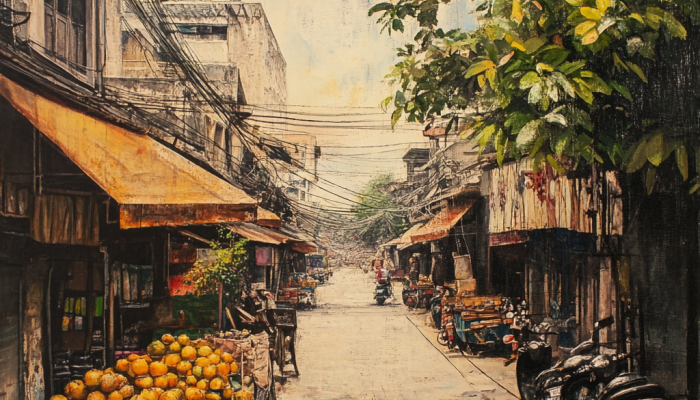Bangkok, the capital city of Thailand, is a fascinating blend of old-world charm and modern innovation. It is a city where skyscrapers dominate the skyline, while ancient temples and serene waterways offer glimpses of the past. This duality defines the heart of Bangkok, where traditional culture and contemporary progress coexist side by side. The contrasts within the city are evident everywhere, from the towering glass and steel buildings that reach for the sky to the tranquil Buddhist temples and traditional markets that seem untouched by time.
The juxtaposition of modernity and tradition in Bangkok creates a unique and dynamic environment. On one hand, the city’s bustling financial district, full of high-rise offices, luxury hotels, and shopping malls, speaks to the rapid development and economic progress that Thailand has made in recent decades. On the other hand, just a short walk away, visitors can find themselves immersed in the calm and peaceful atmosphere of an ancient Buddhist temple, or wander through a traditional Thai market filled with colorful goods and the aroma of local street food. This blend of old and new is one of the most compelling aspects of Bangkok, and it is what makes the city so intriguing to both locals and visitors alike.
Skyscrapers and Modern Architecture
Bangkok’s skyline is one of the most iconic in the world. The city has rapidly transformed in recent years, with sleek, glassy skyscrapers emerging alongside more traditional low-rise buildings. These modern structures, designed by world-renowned architects, serve as symbols of Thailand’s economic growth and global presence. Towering office buildings, luxury condominiums, and high-end shopping malls have reshaped the urban landscape, creating a futuristic cityscape that stretches far into the horizon.
In contrast to the ancient temples and traditional wooden houses, Bangkok’s skyscrapers are a testament to the city’s ambition and forward-thinking mentality. One such building is the Baiyoke Tower II, which, standing at 304 meters, is the tallest building in Thailand. It provides a stunning panoramic view of the city and symbolizes Bangkok’s rapid development in the 21st century. Another example is the MahaNakhon Tower, with its distinctive pixelated design, which has quickly become a recognizable landmark in the city. These modern architectural feats stand in stark contrast to the nearby temples, but they also demonstrate how Bangkok is navigating the delicate balance between preserving its cultural heritage and embracing the future. The city has made impressive strides in creating a global metropolis, all while retaining its unique identity and rich cultural history.
Temples as Spiritual Retreats
Despite the towering skyscrapers and high-tech developments, Bangkok is still deeply rooted in its spiritual traditions:
- The city is home to some of Thailand’s most famous and revered temples, which offer a peaceful retreat from the hustle and bustle of urban life. These temples, or “wats” as they are known in Thai, are not only architectural marvels but also places of worship and meditation for locals and visitors alike.
- The most iconic temple in Bangkok is the Wat Arun, also known as the Temple of Dawn. Located along the Chao Phraya River, Wat Arun is renowned for its stunning central prang (tower), which is decorated with intricate porcelain mosaics that shimmer in the sunlight. The temple’s design is a perfect example of traditional Thai architecture, combining intricate carvings and serene statues with the peaceful ambiance of the river setting.
- Another must-visit temple is Wat Phra Kaew, or the Temple of the Emerald Buddha, located within the Grand Palace. Wat Phra Kaew is considered the most sacred Buddhist temple in Thailand, housing the Emerald Buddha, which is believed to bring good fortune to the country. The temple’s golden spires and ornate decorations make it one of the most beautiful religious sites in the world. Despite the influx of tourists, the temple maintains a tranquil and spiritual atmosphere, offering a rare moment of peace in the midst of a busy city.
- Temples like these are essential to understanding the spiritual life of Bangkok. They offer not only architectural beauty but also a sense of calm and connection to a centuries-old tradition. While the modern skyscrapers symbolize the city’s future, the temples remind us of its rich past and the deep roots of Thai culture.
The Cultural Blend in Markets and Streets
While the skyline and temples highlight the contrast between modern and ancient, Bangkok’s streets and markets offer a fascinating blend of these two worlds. The city is famous for its vibrant street life, where the fast-paced urban environment intersects with the slower, more traditional rhythms of local markets. Walking through the streets of Bangkok, visitors are often struck by the juxtaposition of neon lights from modern stores and the quiet, earthy tones of street vendors selling fresh produce, clothing, and local crafts.
One of the most popular places to experience this blend of old and new is the Chatuchak Market, the largest market in Thailand. With over 15,000 stalls, Chatuchak is a bustling maze of vendors selling everything from antiques and vintage clothes to pets and fresh food. The market is a microcosm of Bangkok’s unique cultural blend, where modern consumerism and traditional craftsmanship meet. Shoppers can purchase the latest fashion trends alongside handcrafted items made using centuries-old techniques, all while enjoying the delicious smell of street food, such as pad Thai, mango sticky rice, and coconut ice cream. The contrast between the neon-lit shopping malls and the open-air, bustling street markets is also striking. In areas like Siam Square, high-end fashion brands and international chains dominate the scene, while just a few blocks away, locals are selling handmade goods and fresh food on the streets. This contrast reflects the dual nature of Bangkok’s culture, where modernity and tradition coexist in a dynamic and often surprising way.
The River of Life: Chao Phraya as a Link Between Two Worlds
One of the most unique features of Bangkok is the Chao Phraya River, which flows through the heart of the city. The river has historically been a vital part of life in Bangkok, serving as a major trade route and a means of transportation for centuries. Today, the river still plays a significant role in daily life, but it also serves as a scenic backdrop to the city’s contrasting elements.
Along the river, you can find a blend of modernity and tradition. On one side of the river, you might see sleek, glassy hotels and luxury apartments. On the other side, there are traditional wooden houses and local markets, where residents still live and work in much the same way their ancestors did. The river serves as a physical and metaphorical link between the old and the new, connecting Bangkok’s rich cultural heritage with its rapidly advancing urban development. Cruising along the Chao Phraya provides a unique perspective on the city’s contrasts. From the water, you can see the juxtaposition of the grand royal palaces and temples with the modern skyscrapers rising behind them. The river offers a serene escape from the hustle and bustle of the streets, allowing visitors to experience the city from a different, more peaceful vantage point.
The Future of Bangkok: A City of Continued Contrasts
As Bangkok continues to grow and evolve, it will likely face even more challenges in balancing its modern development with its cultural heritage. The city is expected to see further urbanization and technological advancements, with more skyscrapers, shopping malls, and infrastructure projects being built in the coming years. However, the preservation of the city’s historic sites and cultural landmarks will remain equally important, as they are integral to the identity of Bangkok.
The future of Bangkok will undoubtedly be shaped by this ongoing tension between the old and the new. The city’s ability to maintain its cultural roots while embracing modernity will determine how it continues to evolve. In a world that is increasingly dominated by rapid technological progress, Bangkok’s ability to blend the old and the new, to seamlessly integrate skyscrapers with temples, will be what keeps it unique.
Questions and Answers
Bangkok is a city of contrasts because it blends modern skyscrapers with ancient temples, bustling markets with serene waterways, and high-tech developments with traditional cultural practices. These elements coexist, offering a unique and dynamic urban experience.
The Chao Phraya River has historically been a vital trade route and remains a link between different parts of the city. The river offers a scenic view of the contrast between modern buildings and traditional homes, serving as a physical and symbolic connection between Bangkok’s past and present.
Bangkok’s markets, such as Chatuchak, are a microcosm of the city’s cultural blend. They combine modern consumerism with traditional craftsmanship, where international brands coexist with locally-made products, showcasing the fusion of old and new in everyday life.
The temples of Bangkok, such as Wat Arun and Wat Phra Kaew, are tranquil, spiritual sites that stand in stark contrast to the bustling, modern skyscrapers. They offer a peaceful retreat and remind visitors of the city’s rich cultural and spiritual heritage amid its rapid urbanization.
Bangkok’s skyscrapers symbolize the city’s rapid development and global economic presence. They reflect Thailand’s ambition to modernize and establish itself as a major global player while still respecting and preserving its cultural heritage.

